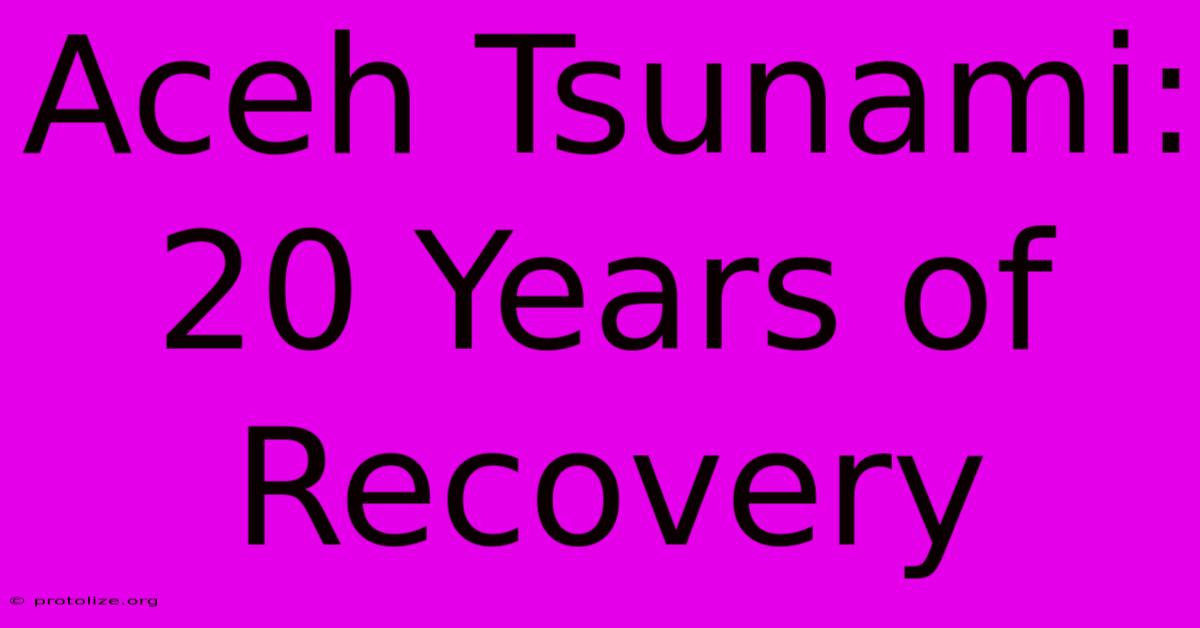Aceh Tsunami: 20 Years Of Recovery

Discover more detailed and exciting information on our website. Click the link below to start your adventure: Visit Best Website mr.cleine.com. Don't miss out!
Table of Contents
Aceh Tsunami: 20 Years of Recovery – A Decade of Resilience
Twenty years ago, the Indian Ocean tsunami devastated Aceh, Indonesia, leaving an indelible mark on the province and its people. The sheer scale of the disaster – over 170,000 lives lost, widespread destruction, and a shattered infrastructure – seemed insurmountable. Yet, in the two decades since, Aceh has shown remarkable resilience, demonstrating a powerful testament to the human spirit and the capacity for recovery. This article explores the journey of Aceh's recovery, highlighting the challenges faced, the progress made, and the lessons learned.
The Immediate Aftermath: Chaos and Hope
The immediate aftermath of the 2004 tsunami was characterized by chaos and devastation. Communication lines were down, infrastructure was in ruins, and the sheer number of casualties overwhelmed rescue efforts. International aid poured in, but the logistical challenges of delivering aid to remote areas were immense. The scale of the destruction was so vast that even experienced disaster relief organizations were initially overwhelmed. However, amidst the despair, there emerged a strong sense of community and hope. Local communities rallied together, supporting each other in the face of unimaginable loss.
Early Recovery Efforts: Challenges and Successes
The early recovery efforts focused on providing immediate necessities: food, water, shelter, and medical care. Rebuilding homes and infrastructure was a monumental task, requiring significant international assistance and coordination. The Indonesian government, along with international NGOs and various countries, embarked on a massive reconstruction program. However, challenges remained. Corruption and bureaucratic hurdles hampered the efficient distribution of aid, and disagreements over land ownership complicated resettlement efforts.
Long-Term Reconstruction: Building a Resilient Aceh
The long-term reconstruction of Aceh was a complex and multifaceted undertaking. It involved not only rebuilding physical infrastructure but also strengthening social structures, revitalizing the economy, and fostering peace and reconciliation.
Infrastructure Development: A New Aceh Takes Shape
Significant progress was made in rebuilding Aceh's infrastructure. New roads, bridges, hospitals, and schools were constructed, often incorporating disaster-resistant designs. The focus shifted from simply replacing what was lost to building a more resilient infrastructure capable of withstanding future natural disasters. Investment in early warning systems was crucial, aiming to prevent a repeat of the devastation caused by the lack of preparedness in 2004.
Economic Recovery: Diversification and Sustainable Growth
The tsunami severely impacted Aceh's economy, particularly its fishing and tourism industries. The long-term recovery involved diversifying the economy and fostering sustainable growth. Efforts were made to support small and medium-sized enterprises (SMEs), providing training and access to credit. The tourism sector slowly recovered, focusing on sustainable tourism practices that minimize environmental impact.
Social and Psychological Healing: A Long Road to Recovery
The psychological scars of the tsunami run deep. Many survivors continue to struggle with trauma and grief. Significant investment in mental health services has been crucial, with various NGOs and government agencies providing counseling and support to affected communities. The process of healing is ongoing, a testament to the long-term impact of such a devastating event.
Lessons Learned and Future Preparedness
The Aceh tsunami served as a stark reminder of the vulnerability of coastal communities to natural disasters. The experience highlighted the importance of:
- Early warning systems: Investing in sophisticated early warning systems that can provide timely and accurate information to at-risk communities is crucial.
- Disaster-resistant infrastructure: Building infrastructure that can withstand the impacts of future tsunamis and other natural disasters is essential.
- Community resilience: Strengthening community participation and empowering local communities to be actively involved in disaster preparedness and recovery.
- International cooperation: Effective international cooperation is crucial for providing timely and effective aid and support to affected regions.
Conclusion: A Testament to Resilience
Twenty years after the devastating tsunami, Aceh stands as a testament to the remarkable resilience of its people. While the scars of the disaster remain, the province has made significant strides in its recovery, rebuilding its infrastructure, diversifying its economy, and strengthening its social fabric. The journey has been long and challenging, but Aceh's progress offers valuable lessons for other communities facing the devastating effects of natural disasters. The experience emphasizes the critical importance of preparedness, resilience, and international cooperation in mitigating the impact of future catastrophes. The story of Aceh's recovery is not just about rebuilding; it's about rebuilding better, stronger, and more resilient.

Thank you for visiting our website wich cover about Aceh Tsunami: 20 Years Of Recovery. We hope the information provided has been useful to you. Feel free to contact us if you have any questions or need further assistance. See you next time and dont miss to bookmark.
Featured Posts
-
Australia Wins 2nd Odi Beats India By 122 Runs
Dec 09, 2024
-
Premier League Fulham 1 1 Arsenal
Dec 09, 2024
-
Implementing A Crm System
Dec 09, 2024
-
Spadaros Analysis Eagles Big Win
Dec 09, 2024
-
Affinity Crm Pricing
Dec 09, 2024
